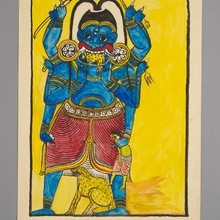Siyawatuk Raksaya
MOA: University of British Columbia
3392/12
A watercolour painting which depicts a spiritual being with a spotted, four-legged animal in its mouth and at its feet. The being has blue skin, ten arms, and three eyes. It is wearing a red skirt that ends just below the knee. The bottom of the skirt has a border made up of white, yellow, black, and red horizontal stripes. The main body of the skirt is covered in thinner horizontal stripes, and consists of two pieces which come together in the front. A thin piece of fabric hangs down from the skirt's waistband, which is decorated with a repeating circular pattern. Adornments are wrapped around the being's chest and neck. Decorative bands encircle its biceps, wrists, and ankles. The being has large, round eyes, and a grinning, fanged mouth. Its black hair is secured by a loop on top of its head, and then splits in two directions to hang down in front of its shoulders. Two large discs with black and white lotus motifs protrude from the side of the being's head. In its mouth is a small, yellow animal with four legs and black spots. In one of its arms the being is holding a small, light green human-like being in a brown skirt. It has a grinning, fanged mouth and black hair. In its other arms the being is holding a long, oblong object, a fork-shaped object, a bell-shaped object with a long handle, a small, hooked object with a long handle, a disembodied face, and a long, curved blade. At the being's feet is a crouching, four-legged animal. The animal is yellow with black spots and has a long face, legs, and ears, as well as a short tail. The painting's background is bright yellow and a rectangular black border surrounds the image. There is an unpainted section behind the being's head.
-
Iconographic Meaning
Identified as a Raksha (demon)/Yakka; mischievous or evil.
-
History Of Use
The imagery is possibly associated with ritual healing in Sri Lanka. The set of watercolours (3392/3-34) is said to depict spirits that inhabit planets, or deviyo (minor gods) or rakshas and yakkas (evil or mischievous beings). These beings are often depicted in masked dances and exorcisms.
-
Narrative
The collector, Dr. Michael Egan, wrote his doctoral thesis on healing rituals in Sri Lanka. His fieldwork was carried out in the south of Sri Lanka, in the village of Kadurupokuna (Hambantota District), between Sept. 1965 and Nov. 1966.
- Type of Item painting
- Culture Sinhalese
- Measurements height 37.4 cm, width 27.4 cm (overall)
- Previous Owner Michael John Egan, Carol Egan
- Received from Carol Egan
- Made in Sri Lanka
- Creation Date between 1960 and 1966
- Collection Date between 1965 and 1966
- Ownership Date before 1977, before October 2, 2019
- Acquisition Date on October 2, 2019
- Item Classes paintings; works on paper
- Condition good
- Accession Number 3392/0012
